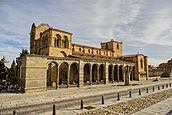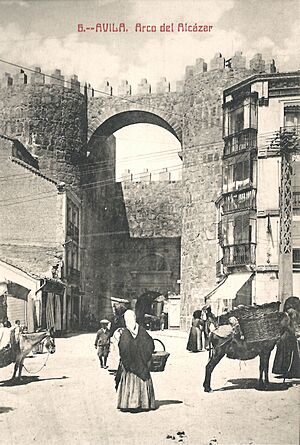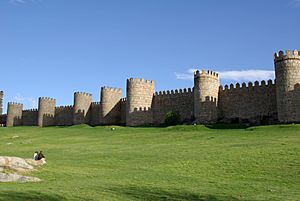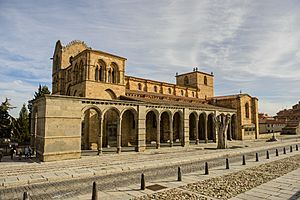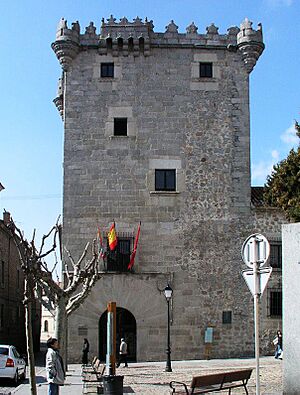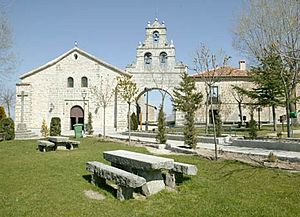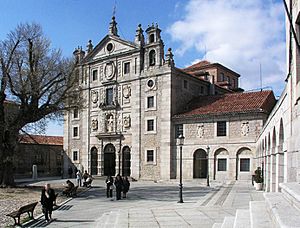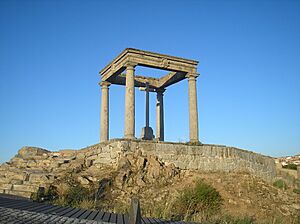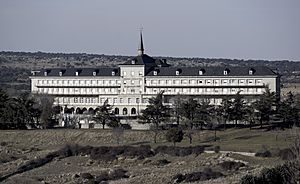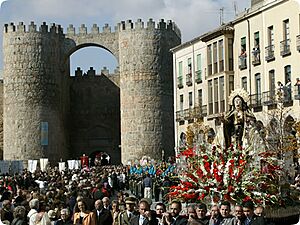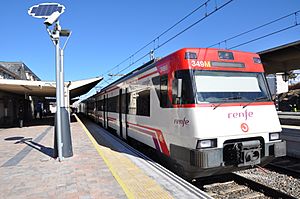Ávila facts for kids
Quick facts for kids
Ávila
|
|||
|---|---|---|---|
|
|
|||
|
|||
| Nicknames:
Ávila de los Caballeros, Ávila del Rey, Ávila de los Leales (Ávila of the knights, Ávila of the king, Ávila of the loyal ones)
|
|||
| Motto(s):
Una ciudad para todos... (A town for everyone...)
|
|||
| Country | Spain | ||
| Autonomous community | Castile and León | ||
| Province | Ávila | ||
| Area | |||
| • Land | 231.9 km2 (89.5 sq mi) | ||
| Elevation | 1,132 m (3,714 ft) | ||
| Population
(2018)
|
|||
| • Total | 57,657 | ||
| Time zone | UTC+1 (CET) | ||
| • Summer (DST) | UTC+2 (CEST) | ||
| Postal code |
05001 - 05006
|
||
| Area code(s) | 34 (Spain) + 920 (Ávila) | ||
| Website | http://www.avila.es | ||
| UNESCO World Heritage Site | |||
| Official name | Old Town of Ávila with its Extra-Muros Churches | ||
| Includes | Hermitage of San Segundo, Basilica of San Vicente, Church of San Andrés, Church of San Pedro, Church of San Nicolás, Church of Santa María de la Cabeza, Church of San Martín, Convent of La Encarnación, Convent of San José, Royal Monastery of Santo Tomás | ||
| Criteria | Cultural: iii, iv | ||
| Inscription | 1985 (9th Session) | ||
| Area | 36.4 ha | ||
Ávila is a city in Spain. It is located in the region of Castile and León. Ávila is the capital and largest town in the Province of Ávila.
The city sits on the right bank of the Adaja river. It is over 1,130 meters (3,700 feet) above sea level. This makes it the highest provincial capital in Spain.
Ávila is famous for its old medieval walls. People sometimes call it the Town of Stones and Saints. It has many Romanesque and Gothic churches. The city's complete medieval walls are built in the Romanesque style. Writer José Martínez Ruiz called it "perhaps the most 16th-century town in Spain."
Ávila is also known by nicknames like Ávila de los Caballeros (Ávila of the knights). Other names are Ávila del Rey (Ávila of the king) and Ávila de los Leales (Ávila of the loyal ones). These names are even on the town's flag.
Filmmaker Orson Welles once said he would most want to live in Ávila. He called it a "strange, tragic place." Parts of his 1965 film Chimes at Midnight were filmed there.
Ávila became a UNESCO World Heritage Site in 1985. This means it is a very important place to protect. The site first included the walled city and four churches outside the walls. More churches have been added since then.
Contents
- Exploring Ávila: Geography and Climate
- Ávila's Long History
- Famous Buildings and Architecture
- The Walls of Ávila: A Giant Fortress
- Ávila Cathedral: Half Church, Half Fortress
- Basílica de San Vicente: An Ancient Basilica
- Convento de San José: Saint Teresa's First Monastery
- Iglesia de San Pedro: Outside the Walls
- Ermita de San Segundo: A Special Hermitage
- Real Monasterio de Santo Tomás: A Dominican Convent
- Santuario de Nuestra Señora de Sonsoles: A Beautiful Sanctuary
- Other Important Buildings
- Conference and Exhibition Centre Lienzo Norte
- Museums and Places to See
- Universities in Ávila
- Sports in Ávila
- Fun Celebrations and Festivals
- Delicious Food in Ávila
- Sister Cities
- Getting Around Ávila
- See also
Exploring Ávila: Geography and Climate
Where is Ávila Located?
Ávila is 1,132 meters (3,714 feet) above sea level. It is built on a rocky hill next to the Adaja river. The river is a branch of the Duero river.
The city is on a flat hilltop. This area is surrounded by a dry, treeless landscape. There are many large grey rocks and tall mountains nearby.
What is Ávila's Weather Like?
Ávila has a temperate Mediterranean climate. This means it has warm summers and chilly winters. Snow often falls in winter.
The hottest month is July, with an average temperature of 20.6°C (69.1°F). The coldest month is January, with an average of 3.0°C (37.4°F). The city gets about 416 mm (16.4 inches) of rain each year.
Ávila's high altitude gives it the coldest winter temperatures among Spanish provincial capitals. The Adaja river can be dry for several months. Because of this, the town has sometimes had problems with its water supply.
| Climate data for Ávila 1,130 metres (3,710 ft) (1983–2010) | |||||||||||||
|---|---|---|---|---|---|---|---|---|---|---|---|---|---|
| Month | Jan | Feb | Mar | Apr | May | Jun | Jul | Aug | Sep | Oct | Nov | Dec | Year |
| Record high °C (°F) | 19.6 (67.3) |
19.8 (67.6) |
22.6 (72.7) |
26.6 (79.9) |
30.6 (87.1) |
35.6 (96.1) |
37.6 (99.7) |
37.4 (99.3) |
36.0 (96.8) |
29.2 (84.6) |
22.4 (72.3) |
19.4 (66.9) |
37.6 (99.7) |
| Mean daily maximum °C (°F) | 7.6 (45.7) |
9.4 (48.9) |
12.6 (54.7) |
14.3 (57.7) |
18.5 (65.3) |
24.6 (76.3) |
28.5 (83.3) |
27.9 (82.2) |
23.4 (74.1) |
16.9 (62.4) |
11.2 (52.2) |
8.4 (47.1) |
17.0 (62.6) |
| Daily mean °C (°F) | 3.0 (37.4) |
4.3 (39.7) |
6.7 (44.1) |
8.5 (47.3) |
12.5 (54.5) |
17.4 (63.3) |
20.6 (69.1) |
20.2 (68.4) |
16.5 (61.7) |
11.4 (52.5) |
6.4 (43.5) |
4.0 (39.2) |
11.0 (51.8) |
| Mean daily minimum °C (°F) | −1.6 (29.1) |
−0.8 (30.6) |
0.8 (33.4) |
2.7 (36.9) |
6.4 (43.5) |
10.2 (50.4) |
12.6 (54.7) |
12.4 (54.3) |
9.6 (49.3) |
5.9 (42.6) |
1.7 (35.1) |
−0.4 (31.3) |
5.0 (41.0) |
| Record low °C (°F) | −16.0 (3.2) |
−12.0 (10.4) |
−13.2 (8.2) |
−8.6 (16.5) |
−4.6 (23.7) |
−1.0 (30.2) |
1.0 (33.8) |
1.4 (34.5) |
−3.0 (26.6) |
−5.4 (22.3) |
−14.0 (6.8) |
−13.4 (7.9) |
−16.0 (3.2) |
| Average precipitation mm (inches) | 34 (1.3) |
24 (0.9) |
23 (0.9) |
40 (1.6) |
55 (2.2) |
33 (1.3) |
12 (0.5) |
19 (0.7) |
30 (1.2) |
53 (2.1) |
48 (1.9) |
42 (1.7) |
416 (16.4) |
| Average precipitation days | 6 | 5 | 4 | 8 | 9 | 5 | 2 | 3 | 4 | 8 | 7 | 7 | 67 |
| Average snowy days | 5 | 4 | 2 | 2 | 0 | 0 | 0 | 0 | 0 | 0 | 2 | 3 | 20 |
| Average relative humidity (%) | 78 | 72 | 63 | 63 | 59 | 51 | 43 | 45 | 56 | 69 | 78 | 79 | 63 |
| Mean monthly sunshine hours | 133 | 154 | 212 | 223 | 253 | 312 | 353 | 322 | 244 | 182 | 131 | 117 | 2,636 |
| Source: Agencia Estatal de Meteorología | |||||||||||||
Ávila's Long History
Early Times and Roman Rule
In ancient times (around 5th century BC), the Vettones people lived in Ávila. They called it Obila, meaning "High Mountain." They built a strong fortress here. You can still see old stone statues of boars, called verracos, nearby.
Later, the Romans took over the town. They called it Abila or Abela. The city's layout is still like a typical Roman town. It has a rectangular shape with two main streets crossing in the middle. Some Roman stones are even part of the town walls today.
It is believed that in the 1st century, a person named Secundus brought Christianity to Ávila. He became its first bishop.
Medieval Times and Reconquest
After the Roman Empire fell, Ávila became a stronghold for the Visigoths. Then, the Moors (Arabs) conquered it and called it Ābila. Christian kingdoms from the north often attacked it. This made it a mostly empty area for a while.
Around 1088, the area was finally taken back by Christians. Raymond of Burgundy helped to rebuild the town. He hired people to build the stone walls that you can still see today.
Ávila became very successful in the early 1500s under the Catholic Monarchs.
Later History and Modern Times
In 1520, during the Revolt of the Comuneros, Ávila was an important meeting place. Leaders met in the Cathedral to discuss new laws for the country.
However, the city started to decline in the 1600s. Its population dropped to only about 4,000 people.
In the 1800s, the population grew a bit with the building of a railway line.
During the Spanish Civil War in 1936, Ávila quickly came under the control of rebel forces. The city continued to grow slowly after that.
Ávila was once home to a large Jewish community. Records show Jews living there as early as 1144. By the late 1200s, it was one of the biggest Jewish communities in the region. In 1492, many Jewish people left Spain. This led to the end of the Jewish community in Ávila.
Famous Buildings and Architecture
The Walls of Ávila: A Giant Fortress
The most famous landmark in Ávila is its huge Walls of Ávila. They were started around 1090. The walls surround an area of 31 hectares (77 acres). They are 2,516 meters (2,752 yards) long.
The walls have 88 semicircular towers and 9 gates. They are about 3 meters (10 feet) thick and 12 meters (39 feet) high. These walls are the largest fully lit monument in the world at night. You can walk on about half of the walls. Some parts cannot be walked on because they are connected to other buildings.
Ávila Cathedral: Half Church, Half Fortress
The Cathedral of Ávila is made of iron-grey granite. Its construction may have started in 1107. Other historians think it was built in the 12th century.
The back part of the church is also part of the town walls. It is like half church, half fortress. Inside, the cathedral has a Latin cross shape with three main areas. The main altar has a large artwork by Pedro Berruguete.
- Northern façade: Gothic style on the left, Renaissance on the right.
- Western front: Has two towers and a covered entrance.
- Interior: Three naves, a central crossing, and an ambulatory (walkway around the altar).
- Choir: Renaissance style, with carvings of saints.
- Tomb of Alonso Tostado: An alabaster tomb of a bishop from 1499.
Basílica de San Vicente: An Ancient Basilica
Building this basilica began in the 12th century and finished in the 14th century. Its design is thought to be by Giral Fruchel. He also worked on the cathedral and brought the Gothic style to Spain.
The church looks like ancient Latin basilicas. It has a Latin cross shape, three naves, and a dome. It also has an entrance area and two towers.
- Interior: Latin cross room with three naves.
- Crypt: Has three chapels. These are mostly Romanesque and have beautiful carved tops on their columns.
A special feature is the Cenotaph of the Holy Brothers Martyrs. This is a monument to Saint Vincent of Ávila and his sisters, Saint Sabina and Saint Cristeta. It is one of the most important Romanesque sculptures in Spain.
Convento de San José: Saint Teresa's First Monastery
The Convent of Saint Joseph was the first monastery for Carmelite nuns. It was founded by Saint Teresa of Jesus in 1562. The church part was built in 1607.
The famous architect Francisco de Mora designed the church. This convent has been a national monument since 1968.
Iglesia de San Pedro: Outside the Walls
The Church of Saint Peter started around 1100. It is located just outside the town walls. It is in the Plaza de Mercado Grande, near the Alcazar gate. Its design is similar to the Basilica of San Vicente.
It has a Latin cross shape with three naves.
Ermita de San Segundo: A Special Hermitage
This hermitage is west of Ávila, outside the walls, by the Adaja river. It has special carved column tops. The alabaster statues inside were made by Juan de Juni.
People believe that if you put a handkerchief into the tomb of Saint Segundo and make three wishes, he will grant one. His pilgrimage is on May 2nd. Saint Segundo is the patron saint of Ávila.
Real Monasterio de Santo Tomás: A Dominican Convent
Real Monasterio de Santo Tomás is a Dominican convent from the late 1400s. Even though it's a bit outside the old city center, it's one of Ávila's most important buildings.
Santuario de Nuestra Señora de Sonsoles: A Beautiful Sanctuary
This sanctuary is about 6 km (3.7 miles) from Ávila. It's in a lovely area with a restaurant, hostel, and picnic spots.
It holds the statue of the Virgin of Sonsoles. She is a co-patroness of Ávila and the patroness of the province's fields. It's a tradition for people to walk barefoot to the sanctuary and make a wish to the Virgin.
Other Important Buildings
Ávila also has many important non-religious buildings. These include the Valderrábanos Palace (15th century) and the Casa de los Deanes (16th century). Other examples are the Torreón de los Guzmanes and the Verdugos Palace (15th–16th centuries).
Conference and Exhibition Centre Lienzo Norte
This modern convention center opened in 2009. It was designed by architect Francisco José Mangado. The building covers 19,800 square meters (213,125 sq ft).
It has a large symphony hall that can hold 2,000 people. There are also glass galleries, a café, a restaurant, and conference rooms.
Museums and Places to See
Ávila has many museums and interesting places to visit:
- Museum of Ávila
- Museum of la Encarnación
- Museum of Santa Teresa
- Museum of the Cathedral
- Museum of Santo Tomás
- Museum of Oriental Art
- Museum of Natural Sciences
- Living Water
- Hall of Torreón de los Guzmanes
- Sala de la Diputación
- Sala del Episcopio
- Caprotti Museum (shows art by Italian painter Guido Caprotti)
Universities in Ávila
Ávila has two universities:
- The Catholic University of Ávila (UCAV)
- The University of Mysticism, which opened in 2008.
There are also three colleges that are part of the University of Salamanca (USAL):
- The Polytechnic School of Ávila
- The College of Education and Tourism in Ávila
- The School of Nursing
Sports in Ávila
Sports Venues
Ávila has many places for sports:
- Town Sport Center: Has swimming pools, tennis courts, and fields for athletics and football.
- North Zone: Has a heated pool, football, basketball, and tennis courts.
- Abulense Casino Club: Offers pools, golf, tennis, and basketball.
- Naturávila: Has golf, swimming, horse riding, and walking paths.
- San Antonio Sports Hall: A large indoor hall for basketball, tennis, and climbing.
- Polideportivo Carlos Sastre: A sports center on the edge of town. It opened in 2009.
Sports Teams
Ávila is home to Óbila CB, a professional basketball team. They play their games at the Multiusos Carlos Sastre.
The local football (soccer) team is Real Ávila CF. They play at the Adolfo Suárez Stadium.
Fun Celebrations and Festivals
The first big festival after winter is Holy Week. It can be cold, especially at night, so warm clothes are needed.
Ávila's main holidays are October 15th (Santa Teresa de Jesús) and May 2nd (San Segundo). The biggest festivals happen around October 15th and in mid-July.
Holy Week: A Tourist Attraction
Holy Week in Ávila is a very important event for tourists. It shows off a lot of art and history. Many processions take place along the town walls. There are usually fifteen or twelve groups (fraternities) that take part in these processions.
Fiestas de Santa Teresa: October Celebrations
The Santa Teresa festivities last almost all of October. The mayor starts the festival in the Plaza Mayor. There are music concerts, a fairground, and bullfights.
On October 15th, the main day, there is a big church service. Then, a large procession takes place. The statue of Santa Teresa is carried from the Cathedral to the Santa Teresa Church.
Delicious Food in Ávila
Ávila has many tasty traditional dishes:
- "Judías del Barco" (beans from Barco)
- "Chuletón de Ávila" (a big steak)
- "Patatas revolconas" (mashed potatoes with paprika)
- "Yemas de Santa Teresa" (a sweet dessert)
You can also find "Hornazo" (a bun filled with sausage, bacon, steak, and eggs). "Mollejas de ternera" (veal sweetbreads) and "Cochinillo" (roast suckling pig) are also popular.
Yemas de Santa Teresa: A Sweet Treat
This famous sweet is always available at "La Flor de Castilla" pastry shop. Other bakeries sell it as "Yemas de Ávila" or simply "Yemas." They are made from egg yolks.
Chuletón de Ávila: A Famous Steak
This is a grilled ribeye steak, often cooked rare. It comes from the Avileña-Negra ibérica cow. This local black cow is known for its excellent meat. You can enjoy this steak in many restaurants in Ávila.
Sister Cities
Ávila is connected with these cities around the world:
Getting Around Ávila
The Ávila Railway Station serves the town. The closest airport is Adolfo Suárez in Madrid. You can reach Ávila by car using the A-6 highway from Madrid.
You can explore the city center on foot. There are also public buses that run throughout the city. A new bus station was built to replace the old one. There is also an underground parking lot in the main square.
The old town area is now closed to private cars. Outside the walls, there are many roundabouts to help traffic flow. A ring road goes around the city, making it easy to cross by car or on foot in less than 30 minutes.
In the 1970s and 80s, Ávila grew a lot. New neighborhoods were built around the old town. Modern services were added, like the Hospital Nuestra Señora de Sonsoles and the Adolfo Suárez stadium. Today, there is also a mall near the hospital.
|
See also
 In Spanish: Ávila para niños
In Spanish: Ávila para niños



